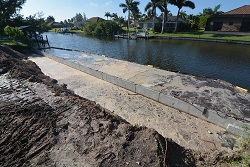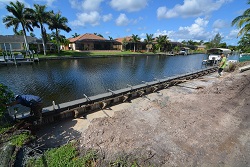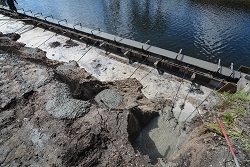The Construction of a Seawall

For lots that have access to the Gulf of Mexico and therefore will experience tidal differences in water level, it is mandatory to construct a seawall before building a home. The chance for erosion on lots with Gulf access canals is much higher.
Seawalls are constructed by 5 ft wide and 8 to 10 ft high concrete panels (you can choose the height you want), which are connected to the panels at the side of your lot and then will be flushed into the soil in the water and reach along the whole width of your waterfront property.
Those panels have a notch so the panels interconnect when side by side.
After the panels have been placed, there is a membrane installed at the notches which will make sure that water can be released from the soil behind the seawall but at the same time keeps the soil in place.
Then the boarding is prepared so the concrete cap of the seawall can be poured. The seawall cap itself will provide the structure much higher rigidness.
In the cap of the seawall, like in the walls at a house, there will be rebars placed to guarantee maximum support.
All these steps are part of the building code and will be checked by a City inspector.
Next, there will be tiebacks or return rods installed from the seawall panels to the soil and secured with a good load of concrete.
These are necessary as when the water level is high, the pressure is very high against the panels from the water side and they need this additional support.
Should the water level get really low, the soil would start putting pressure on the panels and here the tiebacks also support them against being pushed towards the water.
Now the lot can be backfilled and all previously removed soil which was cleaned from rocks and other debris will go back behind the seawall. The seawall is ready and the final inspection can be called in.
Optionally and for an additional amount, you can choose to have an additional seating area installed, called concrete dock or concrete patio.
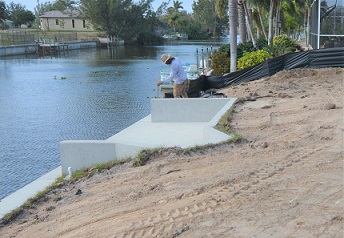
Usually these patios are about 20 ft wide and 13-14 ft deep.
Seawalls need to go through the permit system of the City and need a permit application. This application will be prepared by the contractor you choose for your seawall. To make sure that there are no negative surprises when you try to build a seawall, you should look at a couple things before you buy the lot, which could delay a seawall build or even prevent it completely. This must be done during the feasibility study period we have in all lot purchase contracts.
What is causing delays: Protected animals or plants on or at your lot can be a reason for delays when you want to build a seawall. The most common are Burrowing Owls, Gopher Tortoises, Eagles but also Mangroves to just name a few
Burrowing Owls – These little creatures have their nests underground in little burrows they have dug themselves. As they are on the list of endangered species the City and State take a thorough look before a permit is given. Normally, the owls sit on small wooden crosses checking out the neighborhood. Should their nest be directly on your lot or in the vicinity, the builder/contractor will have to check whether he can keep a 33 ft radius around it where no building activity will occur. If this can not be guaranteed then the owls will have to be relocated by a team of biologists from the City. This will cost you additional time and some money for the removal permit but will not prevent you from building a seawall or home.
Gopher Tortoise – This turtle also is an endangered species and basically the same rules apply like for the burrowing owls.
Eagles – In Cape Coral, this is specifically about the bald eagles. If an active nest is located within 1,100 ft of the construction site then the builder is only allowed to perform noisy building activities during a certain time of the year. The eagles are nesting between October 1st and May 15th. During this time, the eaglets are born and will leave the nest around the beginning of May. Therefore a construction would have to start right after the nesting season ends so that the home can be under roof and all outdoor construction related work can be finished by the end of September. Work inside the house can be performed anytime as long as it does not create disturbing noise for the eagles.
 Mangroves – Mangroves are environmentally protected. The law says that if you have mangroves on or at your property and they need to be removed for construction purposes, you will have to pay a mitigation fee so somewhere else in Florida the same amount of new mangroves can be replanted. In most cases, mangroves can be seen with the bare eye at a visual inspection. Your Realtor can do this if the knows what to look for or you ask the seawall contractor about the existence of mangroves. However to be 100% certain you can order a licensed environmental firm to do this check for you.
Mangroves – Mangroves are environmentally protected. The law says that if you have mangroves on or at your property and they need to be removed for construction purposes, you will have to pay a mitigation fee so somewhere else in Florida the same amount of new mangroves can be replanted. In most cases, mangroves can be seen with the bare eye at a visual inspection. Your Realtor can do this if the knows what to look for or you ask the seawall contractor about the existence of mangroves. However to be 100% certain you can order a licensed environmental firm to do this check for you.
If mangroves are there this will result in 2 things: First the additional time needed as the build for a seawall can tale up to 12 months now because of the additionally involved authorities like the Army Corps of Engineers and the Department of Environmental Protection and the studies they have to prepare. Second you will have to pay for the removed mangroves. In this case the “Wetland Restoration & Mitigation Bank” is being used to collect your payment and route the money to the location where the new mangroves will be planted. The mangrove area will be determined in “Federal Forested Saltwater Credits”, where 0.01 Credits are equivalent to a payment of $2,300. The occupied area of mangroves will be determined through an inspection by the District Corps of Engineers in Jacksonville. The owner has to pay the fee first, otherwise the permit will never be issued.
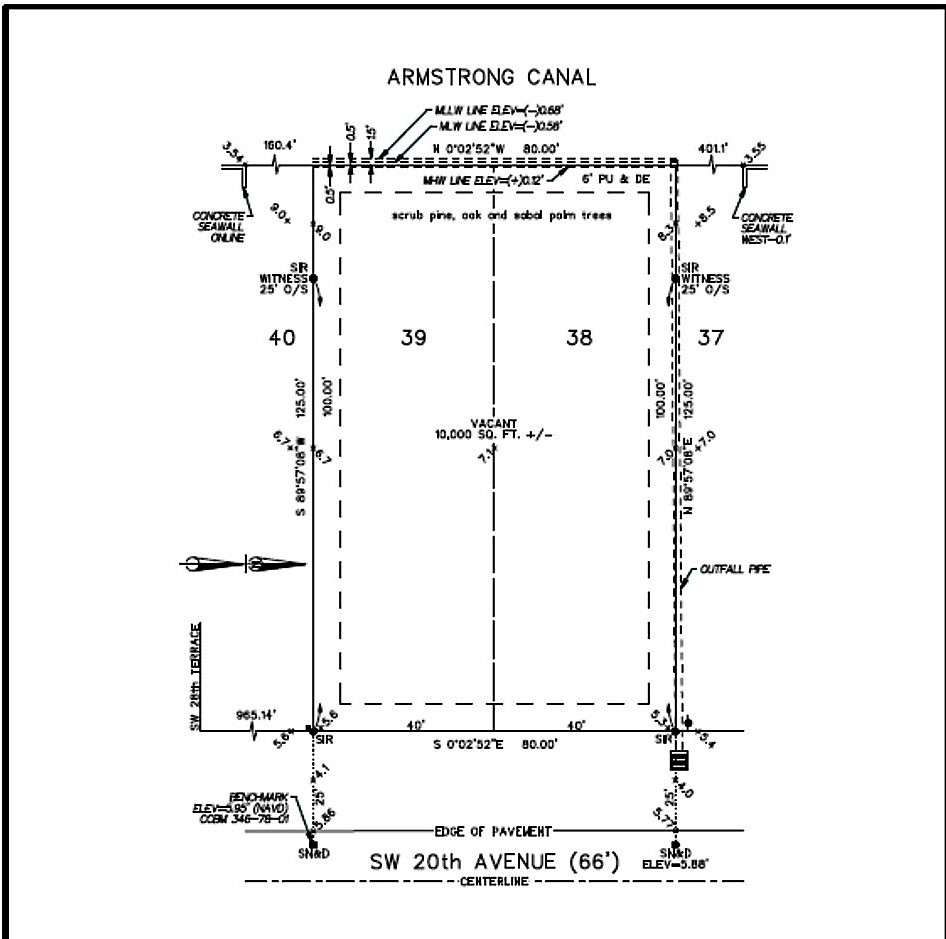 What can prevent you from building? There is actually only one instance and case that I have seen in which building could have been prevented: a stormwater pipe runs right through the middle of your property. This can be found out with a visual inspection but also at the time when a surveyor measures and checks the lot. These cases are pretty rare but they can happen. The reason for this is simple.
What can prevent you from building? There is actually only one instance and case that I have seen in which building could have been prevented: a stormwater pipe runs right through the middle of your property. This can be found out with a visual inspection but also at the time when a surveyor measures and checks the lot. These cases are pretty rare but they can happen. The reason for this is simple.
At the time of the installation of the stormwater pipe it was run along the property boundary line from the street to the canal. The two properties in which middle the pipe was run were oversized properties (3-lot instead of 2-lot). At some point the owners decided to cut off the single lot from each of their properties and combine it. Now a new 2 lot site was created, however the pipe all of a sudden is right in the middle of it. The relocation of such a pipe can easily cost $20,000 or more. This would be a costly surprise if not found out early enough.
Therefore it is always recommended to involve a licensed surveyor when you buy a vacant lot. We can help you in case you cannot be here for the construction of your seawall. From getting an estimate to signing the contract to supervising the construction and providing you with lots of pictures and information, I will guide you through the process.
Important changes: Changes to the building standards of Seawalls have been discussed for years. Due to Hurricane Irma in 2017 and Hurrica Ian in 2022, a noticeable number of old seawalls collapsed and the city has since discussed significant structural changes that ultimately also affect the price.
Almost all of these broken canal walls were from the 60s and had generally reached the end of their durability (old building regulations ..... broken concrete slabs, which then let salt water on uncoated steel struts in the ground and led to total rust). The reversible suction of the hurricane, which pulled the water out of the canals and took the back pressure to the wet earth on the other side, then led to problems with the older installs. Now the time has come: Any permit for a seawall on a canal with gulf access that is released starting March 1st, 2023 must inevitably be adapted to the new, higher concrete wall. The previously 8 ft high concrete panels will then be extended to 10 ft. This means that after the panel has been installed a little deeper in the soil, the wall protrudes approx. 18 inches more out of the water. The poured-on concrete cap is also thicker and wider, as are the dead man anchors. However, this also raises the price, a canal wall for a standard lot can easily be around $25,000 to $35,000.
There will also be changes for freshwater locations and their seawalls in the context of structural reinforcements. From March 1st, 2022 on these seawalls will also become more expensive and will probably start at around $20,000.
The best way to ensure you know what the price of a seawall is when you buy a property is to get a quote during the due diligence period. We're happy to assist!
Video of a seawall build
All information serves as a general orientation about the process. The owner should always verify all given information with the contractor or other licensed companies.





